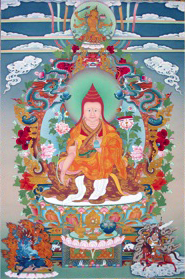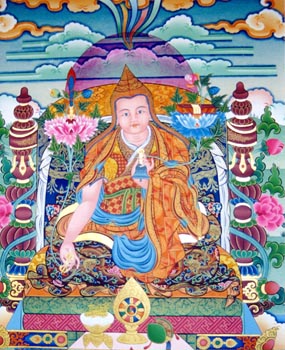Mipham Rinpoche: Difference between revisions
Bj Lhundrup (talk | contribs) No edit summary |
Bj Lhundrup (talk | contribs) No edit summary |
||
| Line 2: | Line 2: | ||
<noinclude><span class=TibUni16>[[མི་ཕམ་རིན་པོ་ཆེ།]]</span></noinclude><br> | <noinclude><span class=TibUni16>[[མི་ཕམ་རིན་པོ་ཆེ།]]</span></noinclude><br> | ||
<noinclude>[[mi pham rin po che]]</noinclude><br> | <noinclude>[[mi pham rin po che]]</noinclude><br> | ||
<noinclude>[[Jamgon Ju Mipham Namgyal]]</noinclude><br> | <noinclude>[[Jamgon Ju Mipham Namgyal]]</noinclude><br> | ||
<noinclude><span class=TibUni16>[[འཇམ་མགོན་འཇུ་མི་ཕམ་རྣམ་རྒྱལ།]]</span></noinclude><br> | <noinclude><span class=TibUni16>[[འཇམ་མགོན་འཇུ་མི་ཕམ་རྣམ་རྒྱལ།]]</span></noinclude><br> | ||
| Line 21: | Line 12: | ||
:::''Homage to Jamgon Mipham.'' | :::''Homage to Jamgon Mipham.'' | ||
<br> | <br> | ||
'''Jamyang Mipham Namgyal Gyatso Rinpoche''' (1846-1912) ranks alongside [[Longchen Rabjam]] and [[Tsongkhapa]] as one of Tibet's most prolific and influential masters. His presentation of the [[Nyingma]] School's unique approach to the view and practice of Buddhism, and in particular the relationship between [[Madhyamaka]] and the [[Great Perfection]], has had an enormous impact on the past few generations of Tibetan Buddhist scholars and practitioners. Namdrolling Monastic College, currently the largest functioning [[Nyingma]] educational institution, includes twenty of his texts in its curriculum. By comparison, only five texts by [[Longchenpa]] are included and only one by [[Rongzom Mahapandita]]. | '''Jamyang Mipham Namgyal Gyatso Rinpoche''' (1846-1912) ranks alongside [[Longchen Rabjam]] and [[Tsongkhapa]] as one of Tibet's most prolific and influential masters. His presentation of the [[Nyingma]] School's unique approach to the view and practice of Buddhism, and in particular the relationship between [[Madhyamaka]] and the [[Great Perfection]], has had an enormous impact on the past few generations of Tibetan Buddhist scholars and practitioners. Namdrolling Monastic College, currently the largest functioning [[Nyingma]] educational institution, includes twenty of his texts in its curriculum. By comparison, only five texts by [[Longchenpa]] are included and only one by [[Rongzom Mahapandita]]. | ||
| Line 36: | Line 22: | ||
Mipham’s most important students were [[Dodrupchen Rinpoche]], the Fifth [[Dzogchen Rinpoche]], Gemang Kyabgon, [[Khenpo Pema Dorje|Khenpo Padmavajra]], [[Gyaltrul Rinpoche|Palyul Gyaltrul]], Karma Yangtrul, [[Tai Situ Rinpoche|Palpung Situ Rinpoche]], Ling Jetrung, [[Adzom Drukpa]], Tokden [[Shakya Shri]], [[Jamyang Loter Wangpo|Ngor Ponlob]], and others. The great tulkus of [[Sechen Monastery]], [[Dzogchen Monastery]], [[Kathok Monastery]], [[Palyul Monastery]], [[Palpung Monastery]], [[Dege Gonchen]], [[Repkong]] and others of all lineages, [[Sakya]], [[Gelug]], [[Kagyu]], and [[Nyingma]], all became his disciples. | Mipham’s most important students were [[Dodrupchen Rinpoche]], the Fifth [[Dzogchen Rinpoche]], Gemang Kyabgon, [[Khenpo Pema Dorje|Khenpo Padmavajra]], [[Gyaltrul Rinpoche|Palyul Gyaltrul]], Karma Yangtrul, [[Tai Situ Rinpoche|Palpung Situ Rinpoche]], Ling Jetrung, [[Adzom Drukpa]], Tokden [[Shakya Shri]], [[Jamyang Loter Wangpo|Ngor Ponlob]], and others. The great tulkus of [[Sechen Monastery]], [[Dzogchen Monastery]], [[Kathok Monastery]], [[Palyul Monastery]], [[Palpung Monastery]], [[Dege Gonchen]], [[Repkong]] and others of all lineages, [[Sakya]], [[Gelug]], [[Kagyu]], and [[Nyingma]], all became his disciples. | ||
Jamgon Mipham Rinpoche was also instrumental in training some of last century’s most important [[Nyingma]] teachers. His most prominent students include [[Khenpo Kunpal]], [[Kathok Situ Rinpoche|Katok Situ]], [[Sechen Rabjam Rinpoche]], [[Khenpo Pema Dorje]], and the | Jamgon Mipham Rinpoche was also instrumental in training some of last century’s most important [[Nyingma]] teachers. His most prominent students include [[Khenpo Kunpal]], [[Kathok Situ Rinpoche|Katok Situ]], [[Sechen Rabjam Rinpoche]], [[Khenpo Pema Dorje]], and the [[terton]] [[Lerab Lingpa]].<br> | ||
<center>'''''Verses by Ju Mipham'''''</center><br> | <center>'''''Verses by Ju Mipham'''''</center><br> | ||
<center>''Whenever there is focus or reference on something, that is poison to the view.''</center> | <center>''Whenever there is focus or reference on something, that is poison to the view.''</center> | ||
| Line 58: | Line 44: | ||
*[[Wangchen Gyerab Dorje]] | *[[Wangchen Gyerab Dorje]] | ||
*[[Patrul Rinpoche]]<br> | *[[Patrul Rinpoche]]<br> | ||
===Main Students=== | ===Main Students=== | ||
*[[Khenpo Kunpal]]<br> | *[[Khenpo Kunpal]]<br> | ||
| Line 67: | Line 52: | ||
*[[Khenpo Shenga]] | *[[Khenpo Shenga]] | ||
*[[Troshul Khenpo Jampal Dorje]] | *[[Troshul Khenpo Jampal Dorje]] | ||
===Main Lineages=== | ===Main Lineages=== | ||
*[[Longchen Nyingthig]]<br> | *[[Longchen Nyingthig]]<br> | ||
===Alternate Names & Spellings=== | ===Alternate Names & Spellings=== | ||
*Lama Mipham Chokle Namgyel | *Lama Mipham Chokle Namgyel | ||
| Line 76: | Line 59: | ||
*Mipham Jamyang Gyamtso | *Mipham Jamyang Gyamtso | ||
*Jampal Gyepe Dorje | *Jampal Gyepe Dorje | ||
*Mipham | *[[Mipham Namgyal]] | ||
*[[Jamgon Mipham]] | |||
*[[Mipham Gyatso]] | |||
*[[Lama Mipham]] | |||
*Jampal Dorje | *Jampal Dorje | ||
*Ju Mipham | *Ju Mipham | ||
*Jñanasara | *Jñanasara | ||
*Ajita | *Ajita | ||
===Other Reference Sources=== | ===Other Reference Sources=== | ||
*[http://www.dharmafellowship.org/biographies/historicalsaints/mipham-namgyal.htm Biographies: The Life of Mipham Jamyang Namgyal (1846–1912)] | *[http://www.dharmafellowship.org/biographies/historicalsaints/mipham-namgyal.htm Biographies: The Life of Mipham Jamyang Namgyal (1846–1912)] | ||
| Line 101: | Line 85: | ||
*[[Commentary on the "Seven-lined Supplication to the Guru"]] Wylie text | *[[Commentary on the "Seven-lined Supplication to the Guru"]] Wylie text | ||
*[[Commentary to "The Supplication of the Vajra Verse"]] Wylie text | *[[Commentary to "The Supplication of the Vajra Verse"]] Wylie text | ||
===External Links=== | ===External Links=== | ||
*[http://www.tbrc.org/cgi-bin/tbrcdatx?do=so&resource=P252 Cataloged Writings of Mipham at TBRC] | *[http://www.tbrc.org/cgi-bin/tbrcdatx?do=so&resource=P252 Cataloged Writings of Mipham at TBRC] | ||
Revision as of 03:07, 17 December 2008
མི་ཕམ་རིན་པོ་ཆེ།
mi pham rin po che
Jamgon Ju Mipham Namgyal
འཇམ་མགོན་འཇུ་མི་ཕམ་རྣམ་རྒྱལ།
'jam mgon 'ju mi pham rnam rgyal
Short Biography
- Repository of the four aspects of perfect intelligence,
- Lord of the kingdom of dharma,
- You were the greatest pandita of your generation:
- Homage to Jamgon Mipham.
Jamyang Mipham Namgyal Gyatso Rinpoche (1846-1912) ranks alongside Longchen Rabjam and Tsongkhapa as one of Tibet's most prolific and influential masters. His presentation of the Nyingma School's unique approach to the view and practice of Buddhism, and in particular the relationship between Madhyamaka and the Great Perfection, has had an enormous impact on the past few generations of Tibetan Buddhist scholars and practitioners. Namdrolling Monastic College, currently the largest functioning Nyingma educational institution, includes twenty of his texts in its curriculum. By comparison, only five texts by Longchenpa are included and only one by Rongzom Mahapandita.
Mipham's primary teachers were Patrul Rinpoche and Jamyang Khyentse Wangpo, both incarnations of the tertön Rigdzin Jigme Lingpa. Khyentsé Rinpoche requested Mipham to preserve the Nyingma teachings through teaching, debate, and composition—a task in which he admirably succeeded. About his remarkable student, Khyentsé remarked: “In this time, there is no one else on earth more learned than Lama Mipham.”
He excelled not only in study and teaching, however, but in practice as well. The numerous retreats he completed were always accompanied by miraculous signs of accomplishment.
Mipham Rinpoche’s collected writings comprise twenty-seven volumes and cover a vast array of topics. Among his most influential writings are The Speech of Delight—a commentary on Shantarakshita's Ornament of the Middle Way, Gateway to Knowledge—which provides an overview of the Buddha’s teachings, and Beacon of Certainty—an elucidation of the view of the Great Perfection and its relationship to the Middle Way teachings.
Mipham’s most important students were Dodrupchen Rinpoche, the Fifth Dzogchen Rinpoche, Gemang Kyabgon, Khenpo Padmavajra, Palyul Gyaltrul, Karma Yangtrul, Palpung Situ Rinpoche, Ling Jetrung, Adzom Drukpa, Tokden Shakya Shri, Ngor Ponlob, and others. The great tulkus of Sechen Monastery, Dzogchen Monastery, Kathok Monastery, Palyul Monastery, Palpung Monastery, Dege Gonchen, Repkong and others of all lineages, Sakya, Gelug, Kagyu, and Nyingma, all became his disciples.
Jamgon Mipham Rinpoche was also instrumental in training some of last century’s most important Nyingma teachers. His most prominent students include Khenpo Kunpal, Katok Situ, Sechen Rabjam Rinpoche, Khenpo Pema Dorje, and the terton Lerab Lingpa.
Literary Works
Main Teachers
Main Students
- Khenpo Kunpal
- Kathok Situ Rinpoche
- Sechen Gyaltsab
- Sechen Rabjam
- Lerab Lingpa
- Khenpo Shenga
- Troshul Khenpo Jampal Dorje
Main Lineages
Alternate Names & Spellings
- Lama Mipham Chokle Namgyel
- Jamgön Mipham Rinpoche
- Mipham Jamyang Gyamtso
- Jampal Gyepe Dorje
- Mipham Namgyal
- Jamgon Mipham
- Mipham Gyatso
- Lama Mipham
- Jampal Dorje
- Ju Mipham
- Jñanasara
- Ajita
Other Reference Sources
- Biographies: The Life of Mipham Jamyang Namgyal (1846–1912)
- The Life and Works of Mipham Rinpoche
- Shower of Blessings Tsok Text Offered by Anyen Rinpoche
- Mipham Rinpoche Timeline
- Mipham's commentary on the Shambhala sections of the Kalachakra Tantra[1]
- Mipham Rinpoche's The Sword of Knowledge with Khenchen Palden Sherab's commentary The Blazing Lights of the Sun and Moon[2]
- "Molten Gold" The Pith Instruction on Looking Into the Mind; A Guide to the Mind entitled Liquid Gold Vomited from the Stomach of a Dog[3]
- The Meaning Of The Vajra Seven Line Prayer To Guru Rinpoche[4]
- Instruction on Attaining Inner Calm[5]
- The Teaching of the Essential Point in Three Words[6]
- The Lion's Roar Proclaiming Extrinsic Emptiness by Mipham Rinpoche[7]
Internal Links
- The Buddha's 80 Minor Marks explained by Mipham Rinpoche
- Commentary on the "Seven-lined Supplication to the Guru" Wylie text
- Commentary to "The Supplication of the Vajra Verse" Wylie text
External Links
- Cataloged Writings of Mipham at TBRC
- Mipham Rinpoche Series on Lotsawa House
- homepage of the 3rd Jamgon Mipham Rinpoche
- Mipham Yahoo group
- Outline: Ju Mipham Sungbum / Mipham Karchag
- Mipham Jamyang Gyatso at Wikipedia
- [Translations of Mipham text by Bodhicitta Sangha
This page was developed by the Rimé Foundation

